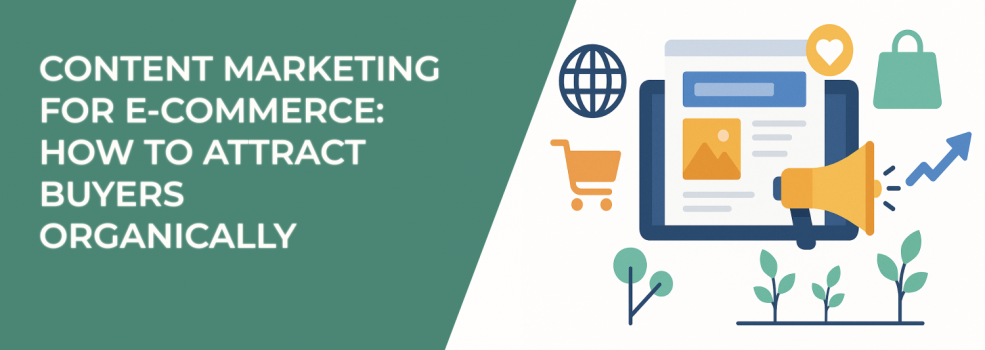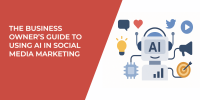In a space where ads dominate every scroll, organic content can feel like a whisper in a shouting match. But for e-commerce businesses that play the long game, content marketing still holds one of the strongest hands on the table.
You don’t need a massive ad budget to get people to your store. You need content that does the talking for you — content that connects, informs, ranks, and converts. So how do you do it right?
Let’s break it down.
Why Content Marketing Still Works in E-Commerce
People don’t just buy products. They buy into stories, solutions, and trust. Content marketing builds all three. It brings in traffic from search, nurtures leads, and keeps your brand top-of-mind — all without paying for every click.
Unlike paid ads, the results compound. A blog post written today can drive sales six months from now. A product guide can keep customers on your site longer and reduce bounce. An educational video can create a relationship before a transaction ever happens.
So why aren’t more e-commerce brands taking it seriously?
Too many assume content takes too long or doesn’t deliver ROI fast enough. The truth is, poorly planned content won’t. But strategic, SEO-driven content? That’s a different story.
For a clear look at how organic strategies can help build a profitable audience, even without constant ad spend, check out how to build ‘no-CPC’ warm audiences.
Start with Search: Let Keywords Lead the Way
E-commerce content that doesn’t consider SEO is like stocking your store in the dark.
Start by finding transactional and informational keywords your buyers are actually searching for. Tools like Google Keyword Planner, Ahrefs, or SEMrush can help, but so can simply observing how your customers talk.
Look for:
-
Long-tail keywords with clear buyer intent — These are specific phrases like “organic cotton baby onesie” or “best wireless earbuds for running.” They often show a strong intention to purchase and are less competitive, making them ideal for ranking.
-
Questions that show confusion or curiosity — Think of phrases like “how to choose the right running shoes” or “do I need an air purifier for allergies?” These are excellent for blog content and help position your brand as a helpful resource.
-
Branded vs. non-branded search patterns — It’s important to know how often users search for your brand versus generic product categories. This tells you how strong your brand awareness is and where to focus content efforts.
-
Keywords that tie directly to product features or solutions — Use terms like “LED desk lamp with USB port” instead of just “desk lamp.” These feature-specific terms help align your content with what buyers care about most.
When your content aligns with what people are already typing into Google, you're not just publishing — you're solving real problems.
Create the Right Content for Every Stage of the Funnel
Not all buyers are ready to hit “add to cart.” That’s why your content should match where they are in the buying journey — awareness, consideration, or decision.
Here’s how to tailor content to each stage:
1. Top of Funnel (Awareness)
At this stage, buyers don’t always know what they’re looking for — they just know they have a need. Your job is to draw them in by offering value without asking for anything in return.
Content ideas:
-
Educational blog posts — Break down common issues or topics your audience faces. For example: “Why Standing Desks Improve Posture and Productivity.” These establish your expertise and bring in traffic from informational searches.
-
How-to videos — Visual learners appreciate tutorials. If you sell kitchen tools, show how to use them. If you sell skincare, show application techniques. These videos can be used across platforms and help build trust.
-
Social content that highlights a common problem — Use short-form content (reels, stories, posts) to spotlight relatable frustrations. This creates immediate emotional connection and engagement.
-
Infographics and data-driven insights — Visual content performs well and helps explain complex ideas quickly. Use data or stats to back up your product’s benefits or market trends.
By showing up with helpful information first, you become a brand they remember — not just one trying to sell.
2. Middle of Funnel (Consideration)
At this point, users are researching. They’re comparing options and trying to figure out what’s worth their money. Now it’s time to be persuasive.
Content ideas:
-
Comparison posts — Articles like “Bamboo Sheets vs. Cotton Sheets: Which Is Better for Hot Sleepers?” help shoppers weigh their options. They position your product as the smarter choice without overt sales pressure.
-
Product guides — A well-structured buying guide can clarify features, use cases, and decision factors. These are especially valuable for high-consideration items like electronics, furniture, or supplements.
-
Case studies or user testimonials — Share real stories from satisfied customers. Show how your product helped solve a problem or improved someone’s life. Authentic social proof builds confidence.
-
Email sequences that nurture interest — If someone signed up but didn’t buy, send them a series of helpful emails that provide tips, reviews, or exclusive content to keep them engaged.
This content helps position your brand as the best choice — not because you say so, but because the buyer feels it.
If you’re not sure how this fits into your broader lead strategy, explore top lead generation tactics for 2025.
3. Bottom of Funnel (Decision)
They’re almost ready to buy — don’t lose them now. At this stage, your content should remove doubt and make conversion easy.
Content ideas:
-
Product-focused landing pages — These should be clean, clear, and designed to convert. Include images, benefits, reviews, FAQs, and trust signals like guarantees or secure checkout.
-
“Why choose us” breakdowns — Create a comparison table or short video that outlines what sets your product apart. Focus on real advantages, not fluff.
-
Urgency-driven messaging — Use countdowns, low-stock notices, or limited-time offers to give buyers a reason to act now — not later.
-
Retargeting content — Ads or emails that remind users about items they viewed or left in the cart. You can also offer helpful nudges like “Still deciding? Here’s what others say about this product.”
If you’re using Meta Ads to re-engage cart abandoners or shoppers on the fence, here’s how to retarget effectively for e-commerce sales.
Repurpose to Multiply Results
One blog post shouldn’t live in just one place. You can stretch a single piece of content into multiple formats that reach different audiences on different channels.
Try this:
-
Turn a blog post into a carousel for Instagram or LinkedIn — Pull out the key takeaways and design them as a swipeable post. This keeps your social media fresh without starting from scratch.
-
Clip a video tutorial into bite-sized reels or TikToks — A five-minute product demo can be split into 15-second tips, perfect for social platforms.
-
Summarize a long guide into an email series — Break complex topics into digestible chunks that go out over a few days. This helps reinforce your message and keep your brand top-of-mind.
-
Use customer comments and reviews as fresh content ideas — User-generated content not only boosts trust but gives you insight into what resonates with buyers. Turn their feedback into testimonials, social posts, or even FAQ content.
Repurposing helps you maintain consistency without burning out your team — and gives your audience more ways to interact with your brand.
Build Trust Before You Sell
One of the most underrated powers of content marketing? Trust.
In a world of dropshipping stores, generic products, and scammy ads, genuine content is a trust signal. It's what shows potential buyers that you're here for more than a quick sale.
Let your content:
-
Answer tough or overlooked questions,
-
Share behind-the-scenes details about your brand or process,
-
Highlight customer experiences with honesty,
-
Own up to challenges and how you solved them.
If you’re looking to expand your reach without stretching your budget, here are ways to attract customers on Facebook organically.
Final Thought: Will You Be Found When They Search?
E-commerce is crowded. Algorithms change. Ads get more expensive. But people will always search. They’ll always ask questions. They’ll always want clarity before commitment.
The brands that win? They’re the ones who show up with answers — clearly, consistently, and organically.
So the question is: when your ideal customer searches, will they find you — or someone else?

